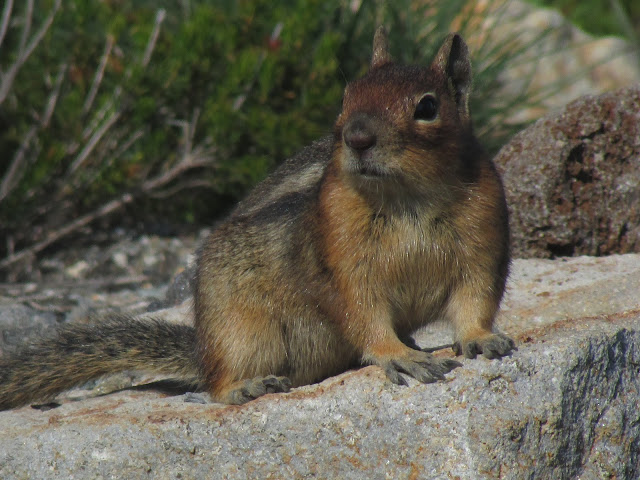 |
| In early August I was greeted by this intense buck head at the start of the Skyline trail at Paradise on Mt. Rainier. Why was he watching so intently? |
 |
| A vigilant parent |
 |
| Ever watchful in the meadows along the trail, while the fawns play |
 |
| Prancing in the meadow |
 |
| A reminder to always take time to stop and smell the flowers |
 |
| Striking white camouflage spots are shown off as the fawn learns about being alert to movement nearby |
 |
| Pausing the game while on alert |
 |
| And now the buck is also wary |
 |
| Full view of the noble beast before they all run off |
 |
| The Mountain in all it's sunny glory. |
 |
| A pretty variety of wildflowers. Flowers on Mt. Rainier have a brief, beautiful 6 week blooming season. |
 |
| This is Red Paintbrush |
 |
| Unique to Mt. Rainier, this is Magenta Paintbrush |
 |
| In the foreground of Mt Rainier, meadow of White Bear Grass, which takes 7 - 10 years to bloom one time in its lifetime. The flower appears hairy looking |
 |
| The dichotomy of flowers springing up by the snow |
 |
| Still plenty of snow in August |
 |
| A close up look at some of the snow ridges |
 |
| Looking across a snow cloud on Mt. Rainier toward Mt Adams in the distance. |
 |
| Sunbathing marmot. |
 |
| Sunbathing marmot close up |
 |
| Marmot watching the hikers on the trail |
 |
| Marmot on alert |
 |
| Meadow marmot |
 |
| Looking over the grasses at marmot level |
 |
| Double waterfall cascading from the melting snow |
 |
| One of the Ptarmigan birds I was lucky to see. The feathers on these birds all turn completely white for the winter snow season. Then they'll burrow underground in the snow perfectly camouflaged. |
 |
| Overlooking a red rock range, highlighted by the setting sun |
 |
| Nearing sunset |
 |
| One of many scurrying squirrels on Mt. Rainier |
 |
| Mt. Squirrel looking for the next adventure |
 |
| In the background is nearby Mt. Adams, at an elevation of 12,280. It hasn't erupted in over 1,000 years but like Mt. Rainier it's not considered extinct. |
 |
| Huckleberries, not quite ripe in early August. I'll have to hike back for this treat. |






No comments:
Post a Comment